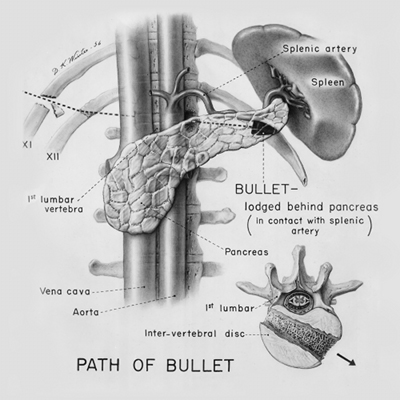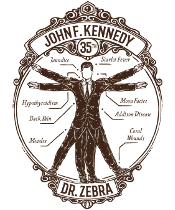

Health and Medical History of President
James GarfieldLived 1831-1881
Health and Medical History of President
James GarfieldLived 1831-1881
1776-1783
1812-1815
1846-1848
1861-1865
1898-1899
1917-1918
1941-1945
1950-1953
1964-1975
1990-1991
2001-2021

| UNDER CONSTRUCTION |
 3
3
The whereabouts of this second bullet was a mystery until the autopsy, despite even the efforts of Alexander Graham Bell. Bell used his newly invented "induction balance," better known now as a metal detector, to attempt locating the bullet. 1b
He was always so cheerful and had so much nerve. Why, he used to astonish me with his jokes, even while he was suffering horribly. Suffer? I should say he did. The first week or ten days it was his feet. He kept saying, "Oh, my God! my feet feel as though there were millions of needles being run through them." I used to squeeze his feet and toes in both my hands, as hard as I possibly could, and that seemed the only relief he could get.Comment: This presumably relates to a post-shooting time. It is difficullt to know what to make of this symptom. It doesn't sound like gout (squeezing would be excruciating). Vascular or neurological causes seem most likely.
Garfield's original wound was 3.5 inches long, and ended with the bullet lodged in a harmless part of the abdomen. The wound was probed by the fingers of numerous physicians during the rest of Garfield's life so that, by the time of his death, the wound track was 20 inches long and oozing pus.
It seems reasonable that the terminal event in Garfield's life was a myocardial infarction. However, the wound could have contributed to the terminal event in three ways, all of them derived from the fact that Garfield was mightily infected for a period of 3 months:
- It seems reasonable to suppose that Garfield had anemia of chronic disease, which would have lowered the ischemic threshold.
- Chronic infection could have led to amyloidosis. If it affected the heart, then it is not surprising that an ischemic event would have been so rapidly fatal.
- It is becoming increasingly clear that coronary atherosclerosis is an inflammatory, perhaps infectious, disease. It is possible that Garfield's chronic inflammation and infection could have accelerated atherosclerosis.
- Both Garfield and his wife were particularly sympathetic to homeopathy. His first cousin, and boyhood neighbor, Silas Boynton, was a homeopathic practitioner. In 1875 Garfield asked Boynton to consult with the physicians caring for his dying mother-in-law. In 1881, while living in the White House, Garfield's wife Lucretia developed malaria, and Boynton was summoned again. Boynton recommended that Mrs. Garfield, who was severely ill, be transferred to the New Jersey seashore, away from the malarious swamps that reached the backyard of the White House. During Garfield's final illness, Boynton and another homeopath (Susan Edson) attended Garfield, but as nurses. 2
- "Some people say that prayer has saved the President. They may think so. In my opinion it was whiskey." Dr. -- D. W. Bliss, physician caring for Garfield after the shooting 6a. (Interestingly, Grant's physician once said just the opposite.)
- Dr. Bliss later died of sepsis (blood poisoning), contracted when he cut his hand while dressing one of Garfield's wounds. 1e [But the Roos article says he died in 1889...]
- Garfield's medical bill was $18,500. 1d
- Doctor Willard Bliss
- Smith Townshend
- Nathan Smith Lincoln
- Basil Norris
- Philip Skinner Wales
- John Brown Hamilton
- Charles Mason Ford
- DeWitt Clinton Patterson
- Charles Burleigh Purvis
- Robert Reyburn
- Joseph Janvier Woodward
- Susan Ann Edson
- Joseph K. Barnes
- Seth R. Beckwith
- William James Chamberlain Du Hamel
- Francis M. Gunnell
- David Low Huntington
- Joel Pomerene
- Brooks, Stewart M. Our Murdered Presidents: The Medical Story. New York: Frederick Fell, 1966.
a p.56 b p.89 c p.85 d p.?? e p.125
Comment: LCC shelving code R703 B873 1966.
- Deppisch, LM. Homeopathic medicine and presidential health: homeopathic influences upon two Ohio presidents. Pharos. Fall 1997;60:5-10. Pubmed: 9385827.
Comment: Discusses the relationships of Garfield and Harding with homeopathy. Also reprints a Currier & Ives drawing of "The Death of General James A. Garfield, Twentieth President of the United States."
- Drawing by Duncan Winter.
- Reif, Wanda. Medical curiosities in cabinets. Out of the blue cabinets. Exhibition at the National Museum of Health and Medicine Washington, DC, USA, showing until May 21, 2000. (Review). Lancet. 2000;355:1467.
- Pendel, Thomas F. Thirty-Six Years in the White House. Washington: Neale Publishing Company, 1902.
 a pp.115-116
a pp.115-116Comment: Pendel was door-keeper at the White House from the time of Lincoln to the time of Theodore Roosevelt. Full text is available on-line at loc.gov. It is a rather dry book, and reads as if it were written by an old man. http://memory.loc.gov/cgi-bin/query/D?lhbcbbib:1:./temp/~~ammem_rEou::
- Boller, Paul F. Jr. Presidential Anecdotes. New York: Oxford University Press, 1981.
 a p.171
a p.171








